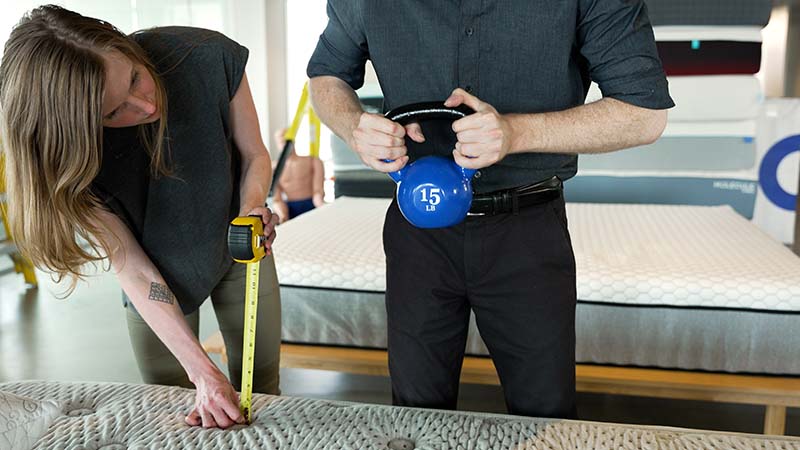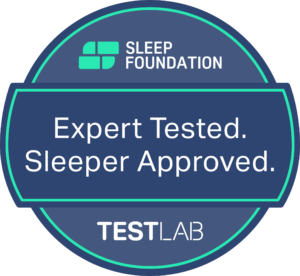Motion Isolation
If you’ve ever struggled to sleep next to someone because you could feel every time they rolled over, you know how important motion isolation can be. On a mattress with excellent motion isolation, you’re unlikely to wake up when your partner climbs into bed, but a mattress with poor motion isolation may leave you wide awake due to your partner’s tossing and turning.
Understanding motion isolation is a crucial part of buying a new mattress, particularly for those who share their bed with another person or a pet. Some materials and mattress types, such as memory foam mattresses, tend to isolate motion exceptionally well. Others, like innerspring mattresses, may not be the right choice for sensitive sleepers.
In the Test Lab, we analyze every product on the market that may lead to sweeter dreams. We put the mattresses we review through a rigorous testing process, including four tests that help us evaluate their motion isolation performance. Through a combination of subjective and objective test results, we’re able to accurately judge a mattress’ performance and compare different mattresses to each other.
We’ll provide more details about our testing process and discuss how to predict a mattress’ motion isolation abilities according to its materials and construction.
What Is Motion Isolation?
Motion isolation describes whether or not movement on one part of the mattress is felt elsewhere on the mattress. A common example is to set a glass of water on the mattress — if it remains upright and unspilled when somebody climbs into bed, the mattress likely has good motion isolation. If it spills, the opposite is likely true.
When sleeping in a bed with strong motion isolation, you likely won’t feel much when your sleep partner rolls over or changes position. If the mattress also has good support around the edges, you may not even notice when they get in or out of bed. That said, no mattress has perfect motion isolation, and you may still sense some movement if you are sleeping very close to your partner.
Who Should Care About Motion Isolation?
Motion isolation is most important to people who share their bed with a partner, children, or pets, especially if they are easily woken by movement.
People move more when sleeping with someone else, with men moving more often than women. Although most people report sleeping better with their partner than they do alone, objective measures of sleep quality are usually lower for co-sleepers, partially due to their partner moving and shifting while asleep. With this in mind, a motion-isolating mattress may be helpful even for people who don’t believe their partner disrupts them.
In the Test Lab, our testers investigate how much movement you can feel from the other side of a mattress. We measure the intensity of vibrations across a mattress as a tester moves between sleeping positions.
Motion isolation is significantly less important for people who sleep alone. There are trade-offs with motion isolation that may also deter people who sleep with a partner. Mattresses that emphasize motion isolation can be less bouncy and more difficult to move on, which can be inconvenient for combination sleepers or people with mobility concerns. The ability to absorb movement can also make a mattress less suitable for sex.
Mattress Materials and Motion Isolation
Some mattress materials are inherently better at isolating motion than others. While support core design is one of the most important factors when considering motion isolation, the use of motion-isolating materials in the transitional and comfort layers can improve the mattress’ overall performance and help alleviate the effect of a motion-transferring core.
| Material | Description | Feel | Motion Isolation Performance |
|---|---|---|---|
| Memory Foam | Memory foam is a type of synthetic foam that contours closely in response to heat and pressure. It adapts to your body as you sleep, then regains its original shape once you’re out of bed. | Most people feel as though they are sleeping in, rather than on, their memory foam mattress. The material is adept at reducing pressure points, but memory foam mattresses tend to sleep quite warm. | Memory foam mattresses are among the best for motion isolation. The material absorbs movement, and its close contouring means that it compresses directly beneath your weight rather than causing the mattress surface to slope. |
| Polyfoam | Polyfoam is similar to memory foam, but it is less dense and has more variation. It can contour closely to the body like memory foam, or it can be made firm enough to use as a support core. Polyfoam is one of the least expensive mattress materials. | Most polyfoam mattresses offer moderate contouring and pressure relief, and they tend to be bouncier and more responsive than memory foam beds. Softer models may trap heat unless the manufacturer has added temperature regulation features. | Polyfoam can perform better or worse on motion isolation depending on how it is made. Softer polyfoam layers may absorb motion almost to the same extent as memory foam, whereas firmer, more resilient polyfoam may transfer some movement. |
| Latex | Latex is traditionally made from the serum found in rubber trees, making latex mattresses popular among sleepers interested in natural materials. Synthetic latex made from petrochemicals is also available. Latex can be manufactured using the Dunlop or the Talalay method, each with a slightly different feel. | Latex mattresses are quite responsive and offer minimal contouring, giving the feeling of sleeping on, rather than in, the bed. Dunlop latex is firmer, while Talalay latex contours more closely but has a natural springiness. Latex absorbs little heat and tends to sleep cool. | While the bounciness of a latex mattress makes it less able to absorb motion, latex mattresses still tend to perform reasonably well. The firmness and type of latex used can have a significant impact on the mattress’ performance. |
| Microcoils | Microcoils tend to be used in a bed’s transitional or comfort layers. These smaller coils are around 1 to 3 inches tall, usually individually wrapped in fabric, and made of flexible metal wires. | Because microcoils are small and often individually wrapped, each coil compresses independently to help form a supportive cradle for the body. Most microcoils allow for plenty of contouring and pressure relief, while also sleeping cooler than foam layers due to the airflow through the coils. | Like all coils, microcoils are naturally bouncy. However, as they tend to be wrapped in fabric and smaller than regular innerspring coils, they offer closer contouring that doesn’t transfer as much movement. |
Motion Isolation by Mattress Type
Mattress type plays a major role in motion isolation, as different support cores respond differently to weight and activity. While each mattress is unique, certain types tend to display significantly better performance in this category than others.
All-Foam Mattresses
All-foam mattresses generally pair a high-density polyfoam support core with one or more polyfoam, memory foam, or latex comfort layers. Of all the mattress types, all-foam mattresses tend to offer the best motion isolation. Although the dense foam core withstands compression, it tends to absorb movement instead of transferring it to the surrounding areas. The caveat is that foam mattresses often have poor edge support, which can cause the mattress surface to dip somewhat when getting out of bed.
Latex Mattresses
Mattresses made entirely from latex typically use softer latex in the comfort layers and firm, dense latex in the core for support and durability. Latex mattresses offer moderate levels of motion isolation. While the softer comfort section is usually able to minimize surface-level movement, the bed’s overall bounciness can cause some transfer when sleepers roll over or change positions. Latex cores do tend to have better edge support than polyfoam cores, which can help reduce the disruption when someone gets out of bed.
Hybrid Mattresses
Hybrid mattresses combine a coil support core with a thick comfort system that is usually made from polyfoam, memory foam, microcoils, or latex. While hybrid mattresses can use any type of coil, most use pocketed coils that are individually encased in fabric. Because pocketed coils compress individually, they perform much better at motion isolation than traditional interconnected coils. The foam or latex comfort layers can further mitigate motion transfer.
Innerspring Mattresses
Most innerspring mattresses feature an interconnected coil design, creating a supportive and bouncy feel. Connected coils move as a unit under pressure, making innerspring mattresses among the worst for motion isolation. Because these mattresses have little to no comfort layers, even small movements can cause a ripple effect throughout the other coils, leading to motion transfer deep in the mattress. The connected coils also cause the mattress surface to tilt if one sleeper is heavier than the other, which can amplify motion transfer.
Airbed Mattresses
Airbeds use inflated air chambers as a support core. Mattresses that use a shared air chamber for two sleepers may have poor motion isolation, while those that have individual air chambers tend to isolate motion relatively well. Airbeds with thicker comfort layers may also absorb more movement.

How Do We Test for Motion Isolation?
A mattress’ construction and materials can give a good indication of its motion isolation performance. However, to truly understand whether a mattress isolates motion effectively, we put each mattress through a number of standardized tests. These tests allow us to judge a mattress’ performance and compare it against the test results of other mattresses.
Testing mattresses isn’t as simple as having someone lay down to see how they feel. To control for random data fluctuations unrelated to the mattress itself, we ensure that each step is standardized and small details are accounted for, down to the movements our testers make when rolling over. This rigorous process helps ensure neutrality during testing and produces results that can be trusted to reflect a mattress’ true performance.
We use four different tests to judge a mattress’ motion isolation performance. Each tells us something different about how the mattress responds to movement. When the scores are combined, we’re able to take a wide-range view of whom a given mattress is right for and who should keep looking.

Body Test – Partner & Kettlebell
In both the partner and kettlebell tests, we use our in-house testers to judge how well a mattress isolates motion. While their notes are subjective, this is the best way to gauge how a mattress feels and whether any motion transfer is likely to disturb someone.
The partner test recreates a typical shared bed. Two testers lay on the bed with a set amount of space between them. The active tester simulates a series of natural movements, including rolling over, changing positions, tossing and turning, getting in and out of bed, and sitting on the edge of the bed. They also perform several more intense motions intended to generate referred motion, such as rhythmically pressing deeply into the bed as if trying to create a wave.


For the kettlebell test, the active sleeper gets out of bed and the passive sleeper remains on the mattress while we drop a 15 pound kettlebell onto the bed from heights of 3 and 5 feet. The kettlebell is dropped from both heights in multiple spots that remain constant from mattress to mattress.
The passive sleeper takes note of the level of disturbance from each test. Because we use the same testing techniques for different mattresses, we are able to compare the performance from one mattress to another.
To control for noise in these experiments, we reinforce the base of the bed to prevent movement or shaking unrelated to the mattress itself.
SensorTag Testing
While subjective results are an important step in the testing process, we also look for objective results to back up the personal experiences of our in-house testers. To achieve these more objective results, we use a device similar to a seismograph that measures waves of movement through the bed.
The test itself involves an in-house tester making the same set of movements as in the partner test. The tool detects any motion in the mattress, including small movements that may not be noticed by a human tester. Some mattresses may move a lot or a little with every motion, while other mattresses may absorb some movements but fail to isolate others. We consider all of these factors when making a final verdict about a mattress’s performance.
Performing the same movements in the same parts of the mattress for both the partner and SensorTag tests allows us to more accurately compare results, both across mattresses and in the subjective versus objective tests.
Liquid Test
The visually striking liquid test is a classic example of motion isolation. In this test, a tester performs typical movements in bed while we measure how these movements affect a container of water on the other side of the bed. The container may spill immediately on a bed with poor motion isolation, while a mattress with excellent motion isolation might keep it upright and stable throughout the test. Between these two extremes, everything from the tilt of the container to ripples in the liquid can offer important information about a mattress’ performance.
Because we want the test to illustrate how a mattress performs in real-life conditions, we do not have our tester jump on the bed. We use the same set of movements every time for this test, including tossing and turning and getting in and out of bed. We also use the same container and amount of liquid every time, and place the container in the same spot on every mattress we test.
The liquid test is useful when testing a mattress, but a high score here doesn’t mean you should set a cup of coffee on your bed. Pressing down on the mattress close to the cup can still spill it, even on a mattress that excels at motion isolation.
Learn more about the Test Lab at the link below.

Frequently Asked Questions About Motion Isolation
Can I improve my bed’s motion isolation?
Mattress toppers can improve a bed’s motion isolation, but only to a point. Toppers made with close-conforming materials like memory foam can have a moderate impact on motion transfer, particularly if your bed also has a solid core. Deeper motion transfer, such as the mechanical transfer caused by connected coils, may be muffled but still somewhat noticeable with a mattress topper. Couples who share a larger mattress may want to consider buying two separate mattress toppers that are less likely to affect each other when one person moves.
What type of mattress is best for motion isolation?
All-foam mattresses with a polyfoam support core and a memory foam comfort system consistently rank high for motion isolation. The polyfoam provides isolated compression for a stable sleep surface, while the memory foam absorbs most surface-level motion. Latex mattresses may also perform well at motion isolation, and hybrid mattresses with pocketed coils and thick comfort layers often fare better than innerspring mattresses with thin comfort sections.
Is it possible to find a motion-isolating innerspring mattress?
Due to their interconnected coil design, most traditional innerspring mattresses perform poorly on motion isolation tests. If you prefer the support of coils but need significant motion isolation, you might want to consider a mattress with pocketed coils. These are usually hybrids, with a foam or latex comfort system that offers additional motion isolation. Since the pocketed coils compress individually, they can have a similar feel to an innerspring while reducing motion transfer. Another option is to buy a mattress topper, which can absorb some movement before it transfers to the coils.


